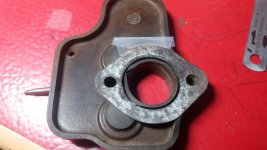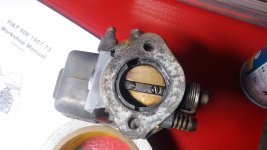Al thank you very much for your long reply, i really appreciate your time and i believe solution is someware between your lines. I will answer your questions one by one.
First of all i haven't done a compression test but i will as soon as i get a pressure gauge kit.
Haven't done a co test on hollow bolts, i don't think they can do that but here is what i done today, i put a small piece of nylon that i got handy to each of one hole on the head. (Hollow bolts are just missing) Start the engine and rev up for a few seconds to see what will happen to nylon and it just stayed there so i am 90% sure no gas is escaping from there but i am living a 10% for further investigation.
Regarding the timing marks as i said my pulley didn't had any of them except the TDC so i made mine in the way you are describing so i am pretty sure they are correct.
As soon as i put the electronic ignition which i believe is better than the point type especially when the distributor is not new and it is a modification that i do in every old vehicle i have/had. The only good thing with point type is reliability, electronics work better but can fail. Anyway it is a mod intended to be for better operation, just my opinion.
Haynes gives 047 to 053mm gap but i think i will agree with you maybe 03 is better and i will readjusted again something between 030-035mm
I think the ''truth'' is someware between the carb and the head. In any case i will remove and overhaul carburetor, a job i can perform with no problem since i have done it many many times with other carbs. Next step will be head overhaul, i am planning to remove inspect and recondition as necessary.
I was wondering if original weber manual is available so i can take a look on it.
I will keep you updated.
Thomas
First of all i haven't done a compression test but i will as soon as i get a pressure gauge kit.
Haven't done a co test on hollow bolts, i don't think they can do that but here is what i done today, i put a small piece of nylon that i got handy to each of one hole on the head. (Hollow bolts are just missing) Start the engine and rev up for a few seconds to see what will happen to nylon and it just stayed there so i am 90% sure no gas is escaping from there but i am living a 10% for further investigation.
Regarding the timing marks as i said my pulley didn't had any of them except the TDC so i made mine in the way you are describing so i am pretty sure they are correct.
As soon as i put the electronic ignition which i believe is better than the point type especially when the distributor is not new and it is a modification that i do in every old vehicle i have/had. The only good thing with point type is reliability, electronics work better but can fail. Anyway it is a mod intended to be for better operation, just my opinion.
Haynes gives 047 to 053mm gap but i think i will agree with you maybe 03 is better and i will readjusted again something between 030-035mm
I think the ''truth'' is someware between the carb and the head. In any case i will remove and overhaul carburetor, a job i can perform with no problem since i have done it many many times with other carbs. Next step will be head overhaul, i am planning to remove inspect and recondition as necessary.
I was wondering if original weber manual is available so i can take a look on it.
I will keep you updated.
Thomas





